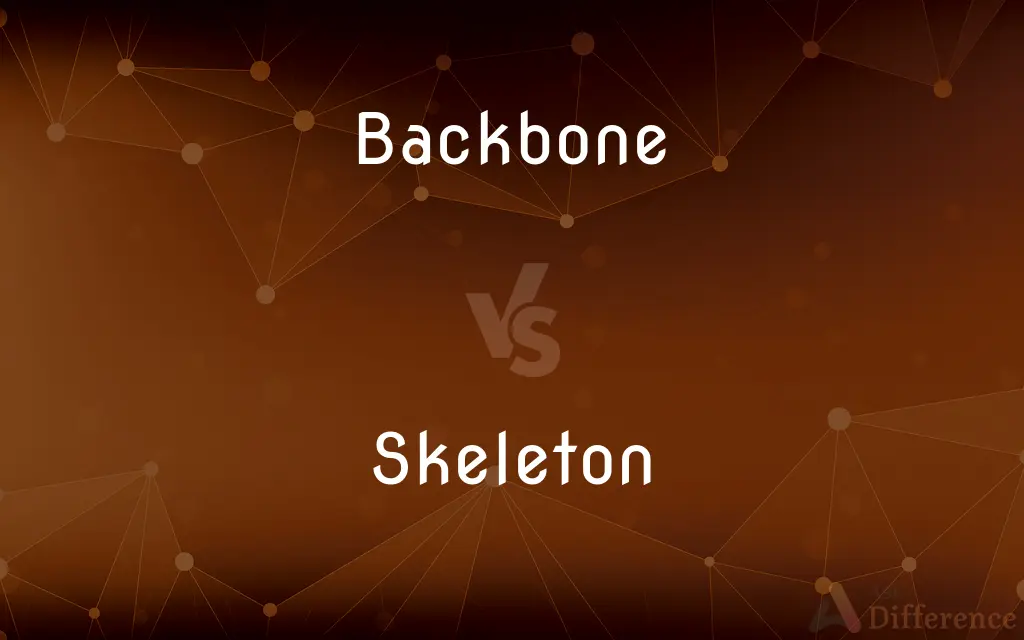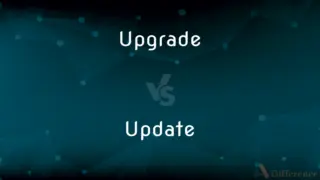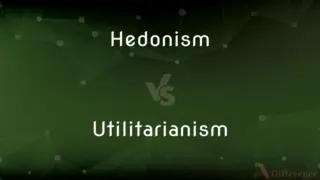Backbone vs. Skeleton — What's the Difference?
By Urooj Arif & Fiza Rafique — Updated on May 5, 2024
Backbone is a term often used to refer to the spine or a metaphor for support or foundational strength, while skeleton refers to the entire framework of bones in a body.

Difference Between Backbone and Skeleton
Table of Contents
ADVERTISEMENT
Key Differences
The backbone, or spine, specifically refers to the series of vertebrae extending from the skull to the small of the back, providing structural support and flexibility to the body. In contrast, the skeleton includes all the bones of the body, supporting the body structure and protecting internal organs.
Backbones are crucial for the movement and upright posture in vertebrates, serving as the main support column that connects different parts of the skeleton. Whereas, the skeleton comprises not only the backbone but also limbs, ribs, skull, and other bones, forming the complete hard structure of an organism.
In human anatomy, the backbone is composed of 33 vertebrae including the lumbar, thoracic, and cervical regions, which play a key role in mobility and stability. On the other hand, the human skeleton consists of 206 bones at adulthood and provides attachment points for muscles, facilitating movement.
The backbone is often used metaphorically to describe the strength and foundational support in various contexts, emphasizing its importance in both physical and figurative support. Meanwhile, the skeleton can also represent the underlying framework or essential structure of an entity, whether in biology or in describing the fundamental aspects of a concept or organization.
Despite both terms sometimes being used metaphorically to imply structure and support, the backbone specifically highlights the central support role, essential for both physical posture and metaphorical 'backbone' in situations requiring resilience. The skeleton, however, suggests a more comprehensive and all-encompassing framework, necessary for overall form and function.
ADVERTISEMENT
Comparison Chart
Definition
The spine of vertebrates, crucial for structural support.
The complete bony framework of an organism.
Composition
Made up of vertebrae including cervical, thoracic, and lumbar regions.
Includes all bones: skull, spine, ribs, limbs, etc.
Function
Provides main support for upright posture and flexibility.
Supports body structure, protects organs, anchors muscles.
Metaphorical use
Symbolizes strength and foundational support.
Represents the underlying framework or structure.
Example in Anatomy
Human backbone consists of 33 vertebrae.
Human skeleton consists of 206 bones at adulthood.
Compare with Definitions
Backbone
The series of vertebrae extending from the skull to the tailbone.
The giraffe's backbone is remarkably long, allowing it to reach high branches.
Skeleton
Something from which everything superfluous has been removed.
The skeleton of the old building was preserved for historical reasons.
Backbone
Something that provides strength or support.
Determination was her backbone through difficult times.
Skeleton
The internal framework of bones in a vertebrate.
The museum displayed the dinosaur's skeleton.
Backbone
Figuratively, moral strength or resilience.
It takes a real backbone to stand up against injustice.
Skeleton
A very basic outline or framework.
The author sketched a skeleton of the novel's plot.
Backbone
A central supporting structure.
The steel beams formed the backbone of the new bridge.
Skeleton
Figuratively, the bare facts or minimal basics of something.
He gave me just the skeleton of the events that transpired.
Backbone
The chief support of a system or organization.
Teachers are often considered the backbone of the educational system.
Skeleton
Used to describe something stripped down to its essentials.
The company reduced to a skeleton crew during the holidays.
Backbone
The vertebrate spine or spinal column.
Skeleton
A skeleton is a structural frame that supports an animal body. There are several different skeletal types: the exoskeleton, which is the stable outer shell of an organism, the endoskeleton, which forms the support structure inside the body, the hydroskeleton, a flexible skeleton supported by fluid pressure, and the cytoskeleton present in the cytoplasm of all cells, including bacteria, and archaea.
Backbone
Something, such as the keel of a ship, that resembles a backbone.
Skeleton
The internal structure that protects and supports the soft organs, tissues, and other parts of a vertebrate organism, and is composed of bone and cartilage or, in certain animals, cartilage alone.
Backbone
The main support or major sustaining factor
The backbone of a thesis.
Skeleton
The hard external structure that supports, protects, or contains the body of many invertebrates, such as mollusks, crustaceans, and corals, and certain vertebrates, such as turtles.
Backbone
Strength of character; determination
Displayed grit and backbone in facing adversity.
Skeleton
A supporting structure or framework, as of a building.
Backbone
A ridge forming the principal axis of a mountain.
Skeleton
An outline or sketch.
Backbone
The principal mountain ridge, range, or system of a region.
Skeleton
Something reduced to its basic or minimal parts.
Backbone
(Chemistry) The main chain of atoms in a polymer.
Skeleton
One that is very thin or emaciated.
Backbone
(Computers) A high-speed communications line that connects smaller, local networks to each other, especially in a wide area network.
Skeleton
A sport in which a person glides down an icy track head-first lying on one's stomach on a compact, simple sled that lacks steering or brakes.
Backbone
The series of vertebrae, separated by disks, that encloses and protects the spinal cord, and runs down the middle of the back in vertebrate animals.
Skeleton
The sled used in such a sport.
Backbone
(figuratively) Any fundamental support, structure, or infrastructure.
Before automobiles, railroads were a backbone of commerce.
Skeleton
Of, relating to, or resembling a skeleton.
Backbone
(figuratively) Courage, fortitude, or strength.
He would make a good manager, if he had a little more backbone.
Skeleton
Reduced to the basic or minimal parts or members
A skeleton crew.
Backbone
The column of bones in the back which sustains and gives firmness to the frame; the spine; the vertebral or spinal column.
Skeleton
Of or relating to the sport of skeleton.
Backbone
Anything like , or serving the purpose of, a backbone.
The lofty mountains on the north side compose the granitic axis, or backbone of the country.
We have now come to the backbone of our subject.
Skeleton
(anatomy) The system that provides support to an organism, internal and made up of bones and cartilage in vertebrates, external in some other animals.
Backbone
Firmness; moral principle; steadfastness.
Shelley's thought never had any backbone.
Skeleton
An anthropomorphic representation of a skeleton.
She dressed up as a skeleton for Halloween.
Backbone
A central cohesive source of support and stability;
Faith is his anchor
The keystone of campaign reform was the ban on soft money
He is the linchpin of this firm
Skeleton
(figuratively) A very thin person.
She lost so much weight while she was ill that she became a skeleton.
Backbone
Fortitude and determination;
He didn't have the guts to try it
Skeleton
(figuratively) The central core of something that gives shape to the entire structure.
The skeleton of the organisation is essentially the same as it was ten years ago, but many new faces have come and gone.
Backbone
The series of vertebrae forming the axis of the skeleton and protecting the spinal cord;
The fall broke his back
Skeleton
(architecture) A frame that provides support to a building or other construction.
Backbone
The part of a network that connects other networks together;
The backbone is the part of a communication network that carries the heaviest traffic
Skeleton
A client-helper procedure that communicates with a stub.
In remote method invocation, the client helper is a ‘stub’ and the service helper is a ‘skeleton’.
Skeleton
(geometry) The vertices and edges of a polyhedron, taken collectively.
Skeleton
(printing) A very thin form of light-faced type.
Skeleton
Reduced to a minimum or bare essentials.
Skeleton
(botany) The network of veins in a leaf.
Skeleton
A type of tobogganing in which competitors lie face down, and descend head first.
Skeleton
(archaic) To reduce to a skeleton; to skin; to skeletonize.
Skeleton
(archaic) To minimize.
Skeleton
The bony and cartilaginous framework which supports the soft parts of a vertebrate animal.
Skeleton
A very thin or lean person.
The great skeleton of the world.
Skeleton
The heads and outline of a literary production, especially of a sermon.
Skeleton
Consisting of, or resembling, a skeleton; consisting merely of the framework or outlines; having only certain leading features of anything; as, a skeleton sermon; a skeleton crystal.
Skeleton
Something reduced to its minimal form;
The battalion was a mere skeleton of its former self
The bare skeleton of a novel
Skeleton
A scandal that is kept secret;
There must be a skeleton somewhere in that family's closet
Skeleton
The hard structure (bones and cartilages) that provides a frame for the body of an animal
Skeleton
The internal supporting structure that gives an artifact its shape;
The building has a steel skeleton
Common Curiosities
What does the skeleton protect in the body?
The skeleton protects vital organs such as the brain, heart, and lungs.
Why is the backbone essential for upright posture?
The backbone provides the necessary support and structure to maintain an upright posture in vertebrates.
How many bones make up the human skeleton?
The human skeleton is made up of 206 bones at adulthood.
How does the backbone contribute to movement?
The backbone allows for flexibility and serves as the attachment point for muscles that facilitate movement.
What are the main components of the backbone?
The main components of the backbone are the cervical, thoracic, and lumbar vertebrae.
What role does the skeleton play in muscle attachment?
The skeleton provides points of attachment for muscles, which are crucial for movement and stability.
What is the primary function of the backbone?
The primary function of the backbone is to provide structural support and flexibility to the body.
Can "skeleton" be used to describe non-physical structures?
Yes, "skeleton" can describe the basic framework or essential outline of non-physical structures like stories or organizations.
Can the term "backbone" be used in a metaphorical sense?
Yes, "backbone" is often used metaphorically to represent strength, support, or the fundamental aspect of something.
How does the skeletal structure differ in different animals?
Skeletal structures vary widely among animals, adapted to different modes of life, such as flying in birds or swimming in fish.
Is the backbone part of the skeleton?
Yes, the backbone is a central part of the skeleton, specifically the vertebral column.
What is the difference between a skeleton and a skull?
The skull is part of the skeleton; it encases the brain and forms the structure of the face and head.
Does the skeleton have any role beyond physical support?
Beyond physical support, the skeleton also plays a role in producing blood cells and storing minerals.
What makes the backbone unique compared to other bones?
The backbone is unique due to its segmented structure and flexibility, which is essential for motion and support.
Is the number of bones in the skeleton always the same in all humans?
No, the number of bones in the human skeleton can vary slightly, especially at birth where there are approximately 270 bones, some of which fuse together by adulthood.
Share Your Discovery

Previous Comparison
Upgrade vs. Update
Next Comparison
Hedonism vs. UtilitarianismAuthor Spotlight
Written by
Urooj ArifUrooj is a skilled content writer at Ask Difference, known for her exceptional ability to simplify complex topics into engaging and informative content. With a passion for research and a flair for clear, concise writing, she consistently delivers articles that resonate with our diverse audience.
Co-written by
Fiza RafiqueFiza Rafique is a skilled content writer at AskDifference.com, where she meticulously refines and enhances written pieces. Drawing from her vast editorial expertise, Fiza ensures clarity, accuracy, and precision in every article. Passionate about language, she continually seeks to elevate the quality of content for readers worldwide.
















































